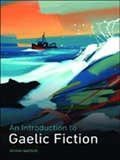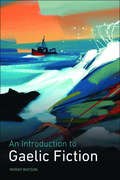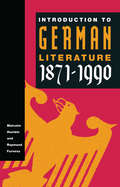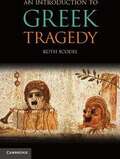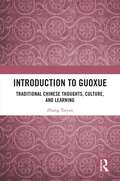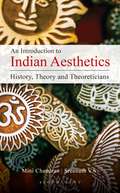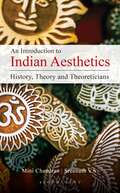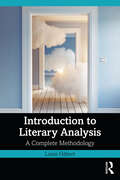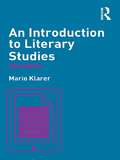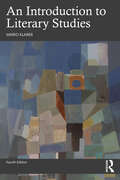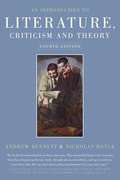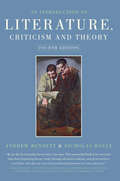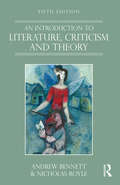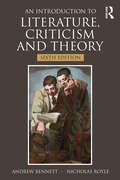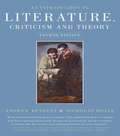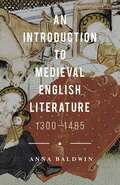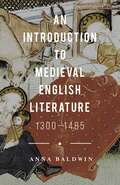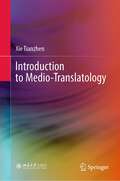- Table View
- List View
An Introduction to Gaelic Fiction
by Moray WatsonThis is the first book to provide a thorough introduction to Gaelic fiction. It traces the evolution of the form over the last century and focuses on the major developments that have led to the recent flourishing in Gaelic fiction publishing. The book follows a broadly chronological structure. The early chapters examine the emergence of fiction at the beginning of the last century, and discuss the cultural context. This leads into a broad exploration of the various kinds of fiction that have been written throughout the century. All of the novels and novellas are examined in turn, from Dùn-Aluinn to Dìleas Donn and Shrapnel, and the book also deals with all the short story collections and a large bulk of the uncollected fiction. As well as covering the work of well-known authors like Iain Moireach, Tormod Caimbeul and Iain Mac a' Ghobhainn, the book has space for many of the lesser-known names that have appeared in magazines such as Gairm. The final chapters focus on the current state of scholarship and criticism of Gaelic fiction and discuss the most recent and remarkable initiatives that have more than sustained the viability of fiction in the Gaelic language. Key Features * The only introduction to Gaelic fiction available * Analyses all novels and novellas, all short story collections, and much of the uncollected fiction * Places Gaelic fiction within a wider context * Examines the critical approaches taken to the fiction so far and introduces research areas that must be explored
An Introduction to Gaelic Fiction
by Moray WatsonThe first book to provide a thorough introduction to Gaelic fiction. It traces the evolution of the form over the last century and focuses on the major developments that have led to the recent flourishing in Gaelic fiction publishing.
An Introduction to German Literature, 1871-1990
by Raymond Furness Malcolm HumbleThe book is an invaluable guide to the literature of the German-speaking countries of the last one hundred and twenty years. It takes as its starting point the Grnderzeit and its prevailing ethos; it traces the breakthrough of die Moderne (Naturalism), the attitudes of fin de sicle aestheticism, the eruption of expressionism, the literature of the Weimar Republic, of Nazism and exile. The post-1945 division is discussed with regard to the divergent literary preoccupations which it engendered: the authors portray West German society as well as that of the former GDR. Their book is able to take stock briefly of the impact on literature of the events of November 9th, 1989.
An Introduction To Greek Tragedy
by Ruth ScodelThis book provides an accessible introduction for students and anyone interested in increasing their enjoyment of Greek tragic plays. Whether readers are studying Greek culture, performing a Greek tragedy, or simply interested in reading a Greek play, this book will help them to understand and enjoy this challenging and rewarding genre. An Introduction to Greek Tragedy provides background information, helps readers appreciate, enjoy and engage with the plays themselves, and gives them an idea of the important questions in current scholarship on tragedy. Ruth Scodel seeks to dispel misleading assumptions about tragedy, stressing how open the plays are to different interpretations and reactions. In addition to general background, the book also includes chapters on specific plays, both the most familiar titles and some lesser-known plays - Persians, Helen and Orestes - in order to convey the variety that the tragedies offer readers.
Introduction to Guoxue: Traditional Chinese Thoughts, Culture, and Learning
by Zhang TaiyanThis book is a collection of Zhang Taiyan's lectures on traditional Chinese thoughts, culture, and learning. Zhang Taiyan is known for his role as an active proponent of Guoxue (Chinese learning) in modern China. This title comprises the transcripts of a series of his lectures on Guoxue given in Shanghai between April and June 1922, and serves as an insightful and influential companion to Guoxue. It systematically introduces the research methods of Guoxue and the development and schools of Chinese classical studies, Chinese philosophy, and Chinese literature, and provides a brilliant analysis of representative figures and works from various periods. It also touches on a wide range of topics in Chinese history, philology, paleography, bibliology, and geography. This book provides Guoxue with many new and thought-provoking ideas and plays a crucial role in the dissemination of Guoxue throughout the world. This title will be essential reading for students and scholars of Sinology and Chinese Studies, as well as for the general public interested in traditional Chinese culture.
Introduction to Guoxue: Traditional Chinese Thoughts, Culture, and Learning
by Zhang TaiyanThis book is a collection of Zhang Taiyan's lectures on traditional Chinese thoughts, culture, and learning. Zhang Taiyan is known for his role as an active proponent of Guoxue (Chinese learning) in modern China. This title comprises the transcripts of a series of his lectures on Guoxue given in Shanghai between April and June 1922, and serves as an insightful and influential companion to Guoxue. It systematically introduces the research methods of Guoxue and the development and schools of Chinese classical studies, Chinese philosophy, and Chinese literature, and provides a brilliant analysis of representative figures and works from various periods. It also touches on a wide range of topics in Chinese history, philology, paleography, bibliology, and geography. This book provides Guoxue with many new and thought-provoking ideas and plays a crucial role in the dissemination of Guoxue throughout the world. This title will be essential reading for students and scholars of Sinology and Chinese Studies, as well as for the general public interested in traditional Chinese culture.
An Introduction to Indian Aesthetics: History, Theory, and Theoreticians
by Mini Chandran Sreenath V.S.The thinkers and philosophers of ancient India contemplated intensively and extensively about all aspects related to life, and art was one of the major domains they touched upon. A profound and intense analysis of the art experience in literature naturally led to the evolution of one of the most sophisticated and long-standing poetic systems in the world.An Introduction to Indian Aesthetics: History, Theory, and Theoreticians offers a comprehensive historical and conceptual overview of all the major schools in Sanskrit poetics-one of the most sophisticated and long-standing traditions of literary criticism in the ancient world. The book, despite its primary focus on the major exponents of each school, also aims to give the reader a good idea as to how these concepts were treated before and after their major practitioners. An important part of Sanskrit poetics that often intimidates a modern reader is its seemingly difficult terminology. This book particularly addresses this issue by using contemporary idioms for readers who have no background of Sanskrit. It also aims to draw points of comparison, wherever relevant, between certain concepts in Sanskrit poetics and their western counterparts.
An Introduction to Indian Aesthetics: History, Theory, and Theoreticians
by Mini Chandran Sreenath V.S.The thinkers and philosophers of ancient India contemplated intensively and extensively about all aspects related to life, and art was one of the major domains they touched upon. A profound and intense analysis of the art experience in literature naturally led to the evolution of one of the most sophisticated and long-standing poetic systems in the world.An Introduction to Indian Aesthetics: History, Theory, and Theoreticians offers a comprehensive historical and conceptual overview of all the major schools in Sanskrit poetics-one of the most sophisticated and long-standing traditions of literary criticism in the ancient world. The book, despite its primary focus on the major exponents of each school, also aims to give the reader a good idea as to how these concepts were treated before and after their major practitioners. An important part of Sanskrit poetics that often intimidates a modern reader is its seemingly difficult terminology. This book particularly addresses this issue by using contemporary idioms for readers who have no background of Sanskrit. It also aims to draw points of comparison, wherever relevant, between certain concepts in Sanskrit poetics and their western counterparts.
Introduction to Literary Analysis: A Complete Methodology
by Louis HébertThis book provides a complete guide to analyzing literary works, from an introduction of basic principles to the finer details. Separated into three sections, the book covers: • Principles—this looks at what literary analysis is, its three main components, and the various possible objects of analysis • Main components—introduces nearly 30 aspects of text analysis, such as style, themes, social aspects, and context, and then goes on to introduce nearly 50 approaches, such as literary history, ecocriticism, narratology, and sociology • The process of analysis—details the general structure of the analytical text, the structure of a pedagogical essay, the analysis of a theoretical element, possible “plans” for the analytical text, methods of argumentation, statements of opinion, hypotheses, the structure of paragraphs, and the use of citations. This book is a synthesis of established scholarship with new, original insights, making it an ideal introduction to the study of literature as well as a valuable companion throughout further study.
Introduction to Literary Analysis: A Complete Methodology
by Louis HébertThis book provides a complete guide to analyzing literary works, from an introduction of basic principles to the finer details. Separated into three sections, the book covers: • Principles—this looks at what literary analysis is, its three main components, and the various possible objects of analysis • Main components—introduces nearly 30 aspects of text analysis, such as style, themes, social aspects, and context, and then goes on to introduce nearly 50 approaches, such as literary history, ecocriticism, narratology, and sociology • The process of analysis—details the general structure of the analytical text, the structure of a pedagogical essay, the analysis of a theoretical element, possible “plans” for the analytical text, methods of argumentation, statements of opinion, hypotheses, the structure of paragraphs, and the use of citations. This book is a synthesis of established scholarship with new, original insights, making it an ideal introduction to the study of literature as well as a valuable companion throughout further study.
An Introduction to Literary Studies
by Mario KlarerIn this classic beginner's guide to English literature, Mario Klarer offers a concise and accessible discussion of central issues in the study of literary texts, looking at: definitions of key terms such as literature and text the genres of fiction, poetry, drama, and film periods and classifications of literature theoretical approaches to texts the use of secondary resources guidelines for writing research essays The new and expanded edition is fully updated to include: a wider range of textual examples from world literature additional references to contemporary cinema, a section on comparative literature an extended survey of literary periods and genres recent changes in MLA guidelines information on state-of-the-art citation management software the use and abuse of online resources. The book also features suggestions for further reading as well as an extensive glossary of key terms.
An Introduction to Literary Studies
by Mario KlarerIn this classic beginner's guide to English literature, Mario Klarer offers a concise and accessible discussion of central issues in the study of literary texts, looking at: definitions of key terms such as literature and text the genres of fiction, poetry, drama, and film periods and classifications of literature theoretical approaches to texts the use of secondary resources guidelines for writing research essays The new and expanded edition is fully updated to include: a wider range of textual examples from world literature additional references to contemporary cinema, a section on comparative literature an extended survey of literary periods and genres recent changes in MLA guidelines information on state-of-the-art citation management software the use and abuse of online resources. The book also features suggestions for further reading as well as an extensive glossary of key terms.
An Introduction to Literary Studies
by Mario KlarerThe fourth edition of this classic beginner’s guide to literary studies has been fully updated throughout. Mario Klarer offers a concise and accessible discussion of central issues in English and world literature as well as film and television series. Starting with the basics of what constitutes a literary text, the book moves through an analysis of major genres, important periods, and key theoretical approaches to literature and film. It also looks at the practicalities of finding and referencing secondary sources when writing a research paper. The expanded new edition has been updated to include: a wider range of examples from world literature, cinema, and television series additional references to contemporary streaming formats updated chapters on postcolonial theory, cultural studies, gender theory, feminism, and queer theory new sections on digital humanities, ecocriticism, literary translations, and paratexts extended explanations of traditional genres, e.g., the epic, drama, and poetry a completely revised chapter on the most recent MLA guidelines with rules for citing new media formats The detailed glossary ensures that the book is accessible to readers of any level, making this an ideal self-study guide or a course book for Introduction to Literature classes.
An Introduction to Literary Studies
by Mario KlarerThe fourth edition of this classic beginner’s guide to literary studies has been fully updated throughout. Mario Klarer offers a concise and accessible discussion of central issues in English and world literature as well as film and television series. Starting with the basics of what constitutes a literary text, the book moves through an analysis of major genres, important periods, and key theoretical approaches to literature and film. It also looks at the practicalities of finding and referencing secondary sources when writing a research paper. The expanded new edition has been updated to include: a wider range of examples from world literature, cinema, and television series additional references to contemporary streaming formats updated chapters on postcolonial theory, cultural studies, gender theory, feminism, and queer theory new sections on digital humanities, ecocriticism, literary translations, and paratexts extended explanations of traditional genres, e.g., the epic, drama, and poetry a completely revised chapter on the most recent MLA guidelines with rules for citing new media formats The detailed glossary ensures that the book is accessible to readers of any level, making this an ideal self-study guide or a course book for Introduction to Literature classes.
An Introduction To Literature: Criticism And Theory
by Andrew Bennett Nicholas RoyleFresh, original and compelling, An Introduction to Literature, Criticism and Theory is the essential guide to literary studies. Starting at 'the beginning' and concluding with 'the end', the book covers topics that range from the familiar (character, narrative, the author) to the more unusual (secrets, pleasure, ghosts). Eschewing abstract isms, Bennett and Royle successfully illuminate complex ideas by engaging directly with literary works - so that a reading of Jane Eyreopens up ways of thinking about racial difference, whilst Chaucer, Raymond Chandler and Monty Python are all invoked in a discussion of literary laughter. Each chapter ends with a narrative guide to further reading and the book also includes a glossary and bibliography. The fourth edition has been revised to incorporate two timely new chapters on animals and the environment. A breath of fresh air in a field that can often seem dry and dauntingly theoretical, this book will open the reader's eyes to the exhilarating possibilities of both reading and studying literature. 9781405859141
An Introduction To Literature: Criticism And Theory (PDF)
by Andrew Bennett Nicholas RoyleFresh, original and compelling, An Introduction to Literature, Criticism and Theory is the essential guide to literary studies. Starting at 'the beginning' and concluding with 'the end', the book covers topics that range from the familiar (character, narrative, the author) to the more unusual (secrets, pleasure, ghosts). Eschewing abstract isms, Bennett and Royle successfully illuminate complex ideas by engaging directly with literary works - so that a reading of Jane Eyreopens up ways of thinking about racial difference, whilst Chaucer, Raymond Chandler and Monty Python are all invoked in a discussion of literary laughter. Each chapter ends with a narrative guide to further reading and the book also includes a glossary and bibliography. The fourth edition has been revised to incorporate two timely new chapters on animals and the environment. A breath of fresh air in a field that can often seem dry and dauntingly theoretical, this book will open the reader's eyes to the exhilarating possibilities of both reading and studying literature. 9781405859141
An Introduction to Literature, Criticism and Theory
by Andrew Bennett Nicholas RoyleLively, original and highly readable, An Introduction to Literature, Criticism and Theory is the essential guide to literary studies. Starting at 'The Beginning' and concluding with 'The End', chapters range from the familiar, such as 'Character', 'Narrative' and 'The Author', to the more unusual, such as 'Secrets', 'Pleasure' and 'Ghosts'. Now in its fifth edition, Bennett and Royle's classic textbook successfully illuminates complex ideas by engaging directly with literary works, so that a reading of Jane Eyreopens up ways of thinking about racial difference, for example, while Chaucer, Raymond Chandler and Monty Python are all invoked in a discussion of literature and laughter. The fifth edition has been revised throughout and includes four new chapters - 'Feelings', 'Wounds', 'Body' and 'Love' - to incorporate exciting recent developments in literary studies. In addition to further reading sections at the end of each chapter, the book contains a comprehensive bibliography and a glossary of key literary terms. A breath of fresh air in a field that can often seem dry and dauntingly theoretical, this book will open the reader's eyes to the exhilarating possibilities of reading and studying literature.
An Introduction to Literature, Criticism and Theory
by Andrew Bennett Nicholas RoyleLively, original and highly readable, An Introduction to Literature, Criticism and Theory is the essential guide to literary studies. Starting at ‘The Beginning’ and concluding with ‘The End’, chapters range from the familiar, such as ‘Character’, ‘Narrative’ and ‘The Author’, to the more unusual, such as ‘Secrets’, ‘Pleasure’ and ‘Ghosts’. Now in its fifth edition, Bennett and Royle’s classic textbook successfully illuminates complex ideas by engaging directly with literary works, so that a reading of Jane Eyre opens up ways of thinking about racial difference, for example, while Chaucer, Raymond Chandler and Monty Python are all invoked in a discussion of literature and laughter. The fifth edition has been revised throughout and includes four new chapters – ‘Feelings’, ‘Wounds’, ‘Body’ and ‘Love’ – to incorporate exciting recent developments in literary studies. In addition to further reading sections at the end of each chapter, the book contains a comprehensive bibliography and a glossary of key literary terms. A breath of fresh air in a field that can often seem dry and dauntingly theoretical, this book will open the reader’s eyes to the exhilarating possibilities of reading and studying literature.
An Introduction to Literature, Criticism and Theory
by Andrew Bennett Nicholas RoyleLively, original and highly readable, An Introduction to Literature, Criticism and Theory is the essential guide to literary studies. Starting at ‘The Beginning’ and concluding with ‘The End’, chapters range from the familiar, such as ‘Character’, ‘Narrative’ and ‘The Author’, to the more unusual, such as ‘Secrets’, ‘Pleasure’ and ‘Ghosts’. Now in its fifth edition, Bennett and Royle’s classic textbook successfully illuminates complex ideas by engaging directly with literary works, so that a reading of Jane Eyre opens up ways of thinking about racial difference, for example, while Chaucer, Raymond Chandler and Monty Python are all invoked in a discussion of literature and laughter. The fifth edition has been revised throughout and includes four new chapters – ‘Feelings’, ‘Wounds’, ‘Body’ and ‘Love’ – to incorporate exciting recent developments in literary studies. In addition to further reading sections at the end of each chapter, the book contains a comprehensive bibliography and a glossary of key literary terms. A breath of fresh air in a field that can often seem dry and dauntingly theoretical, this book will open the reader’s eyes to the exhilarating possibilities of reading and studying literature.
An Introduction to Literature, Criticism and Theory
by Andrew Bennett Nicholas RoyleLively, original and highly readable, An Introduction to Literature, Criticism and Theory is the essential guide to literary studies. Starting at ‘The Beginning’ and concluding with ‘The End’, chapters range from the familiar, such as ‘Character’, ‘Narrative’ and ‘The Author’, to the more unusual, such as ‘Secrets’, ‘Pleasure’ and ‘Ghosts’. Now in its sixth edition, Bennett and Royle’s classic textbook successfully illuminates complex ideas by engaging directly with literary works, so that a reading of Jane Eyre opens up ways of thinking about racial difference, for example, while Chaucer, Monty Python and Hilary Mantel are all invoked in a discussion of literature and laughter. The sixth edition has been revised and updated throughout. In addition, four new chapters – ‘Literature’, ‘Loss’, ‘Human’ and ‘Migrant’ – engage with exciting recent developments in literary studies. As well as fully up-to-date further reading sections at the end of each chapter, the book contains a comprehensive bibliography and an invaluable glossary of key literary terms. A breath of fresh air in a field that can often seem dry and dauntingly theoretical, this book will open the reader’s eyes to the exhilarating possibilities of reading and studying literature.
An Introduction to Literature, Criticism and Theory
by Andrew Bennett Nicholas RoyleLively, original and highly readable, An Introduction to Literature, Criticism and Theory is the essential guide to literary studies. Starting at ‘The Beginning’ and concluding with ‘The End’, chapters range from the familiar, such as ‘Character’, ‘Narrative’ and ‘The Author’, to the more unusual, such as ‘Secrets’, ‘Pleasure’ and ‘Ghosts’. Now in its sixth edition, Bennett and Royle’s classic textbook successfully illuminates complex ideas by engaging directly with literary works, so that a reading of Jane Eyre opens up ways of thinking about racial difference, for example, while Chaucer, Monty Python and Hilary Mantel are all invoked in a discussion of literature and laughter. The sixth edition has been revised and updated throughout. In addition, four new chapters – ‘Literature’, ‘Loss’, ‘Human’ and ‘Migrant’ – engage with exciting recent developments in literary studies. As well as fully up-to-date further reading sections at the end of each chapter, the book contains a comprehensive bibliography and an invaluable glossary of key literary terms. A breath of fresh air in a field that can often seem dry and dauntingly theoretical, this book will open the reader’s eyes to the exhilarating possibilities of reading and studying literature.
An Introduction To Literature, Criticism And Theory (PDF)
by Andrew Bennett Nicholas RoyleFresh, original and compelling, "An Introduction to Literature, Criticism and Theory "is the essential guide to literary studies. Starting at the beginning and concluding with the end, the book covers topics that range from the familiar (character, narrative, the author) to the more unusual (secrets, pleasure, ghosts). Eschewing abstract "isms," Bennett and Royle successfully illuminate complex ideas by engaging directly with literary works so that a reading of "Jane Eyre" opens up ways of thinking about racial difference, whilst Chaucer, Raymond Chandler and Monty Python are all invoked in a discussion of literary laughter. Each chapter ends with a narrative guide to further reading and the book also includes a glossary and bibliography. The fourth edition has been revised to incorporate two timely new chapters on animals and the environment. A breath of fresh air in a field that can often seem dry and dauntingly theoretical, this book will open the reader s eyes to the exhilarating possibilities of both reading and studying literature. "
An Introduction to Medieval English Literature: 1300-1485
by Anna BaldwinThis is a comprehensive guide to a literary period characterized by great variety and imagination, and vividly alert to the social transformations overtaking society. Spanning almost two centuries, it introduces the reader to a diverse range of authors writing for a fast-developing readership of both men and women. Each chapter focuses on a group of genres primarily associated with a particular social class – from the Drama and Saints' Lives accessible to the illiterate, to the sophisticated Romances of Love savoured by the aristocracy and the Court. Lively historical narratives place each group of texts in their social, political and cultural contexts. Significant or typical texts are given more detailed analysis that includes critical issues and questions to guide the reader's own approach, and each section is supported by a detailed bibliography of further reading.
An Introduction to Medieval English Literature: 1300-1485
by Anna BaldwinThis is a comprehensive guide to a literary period characterized by great variety and imagination, and vividly alert to the social transformations overtaking society. Spanning almost two centuries, it introduces the reader to a diverse range of authors writing for a fast-developing readership of both men and women. Each chapter focuses on a group of genres primarily associated with a particular social class – from the Drama and Saints' Lives accessible to the illiterate, to the sophisticated Romances of Love savoured by the aristocracy and the Court. Lively historical narratives place each group of texts in their social, political and cultural contexts. Significant or typical texts are given more detailed analysis that includes critical issues and questions to guide the reader's own approach, and each section is supported by a detailed bibliography of further reading.
Introduction to Medio-Translatology
by Xie TianzhenThis book offers a comprehensive introduction to medio-translatology, including its historical and literary setting, its core concept, and its practice and theory. Medio-translatology, inspired by scholarship in comparative literature and the “cultural turn” in Western translation studies, has tackled many issues which previously went unnoticed or were ignored in traditional translation studies in China; it falls within the scope of literary studies and cultural studies, extending beyond the confines of language and treating literary translations and translating as historical facts.Emerging from comparative literature, medio-translatology looks at literary translation from a new and broader perspective, and explains, with illustrative and compelling examples, that literary translation is “an act of creative treason.” The originality of this approach is also evident in its distinguishing between the history of translated literature and the history of literary translation, as well as in its addressing the nature and status of translated literature.The Chinese edition of this book, being the first of its kind and well received in China, has been hailed as a milestone in exploring translation studies in the context of comparative literature in Chinese academia, and it introduces to students and researchers alike a wide range of new thoughts and ideas.
